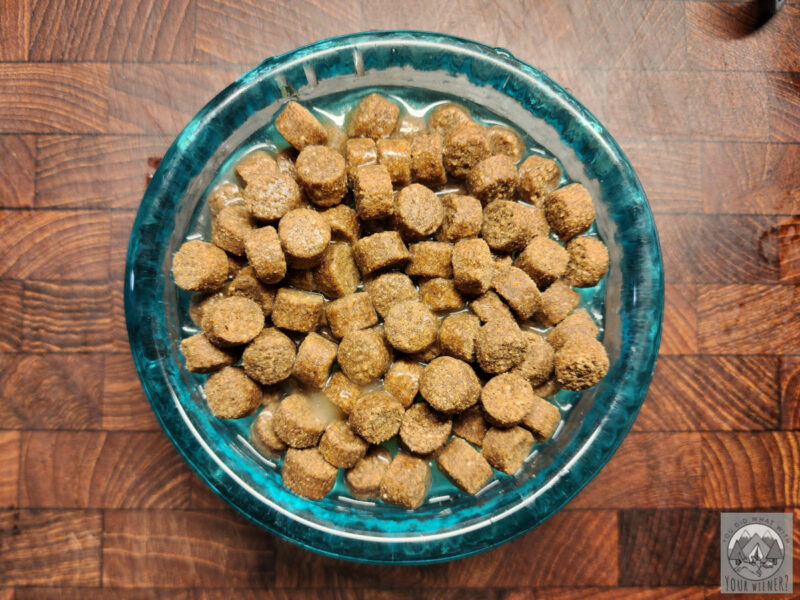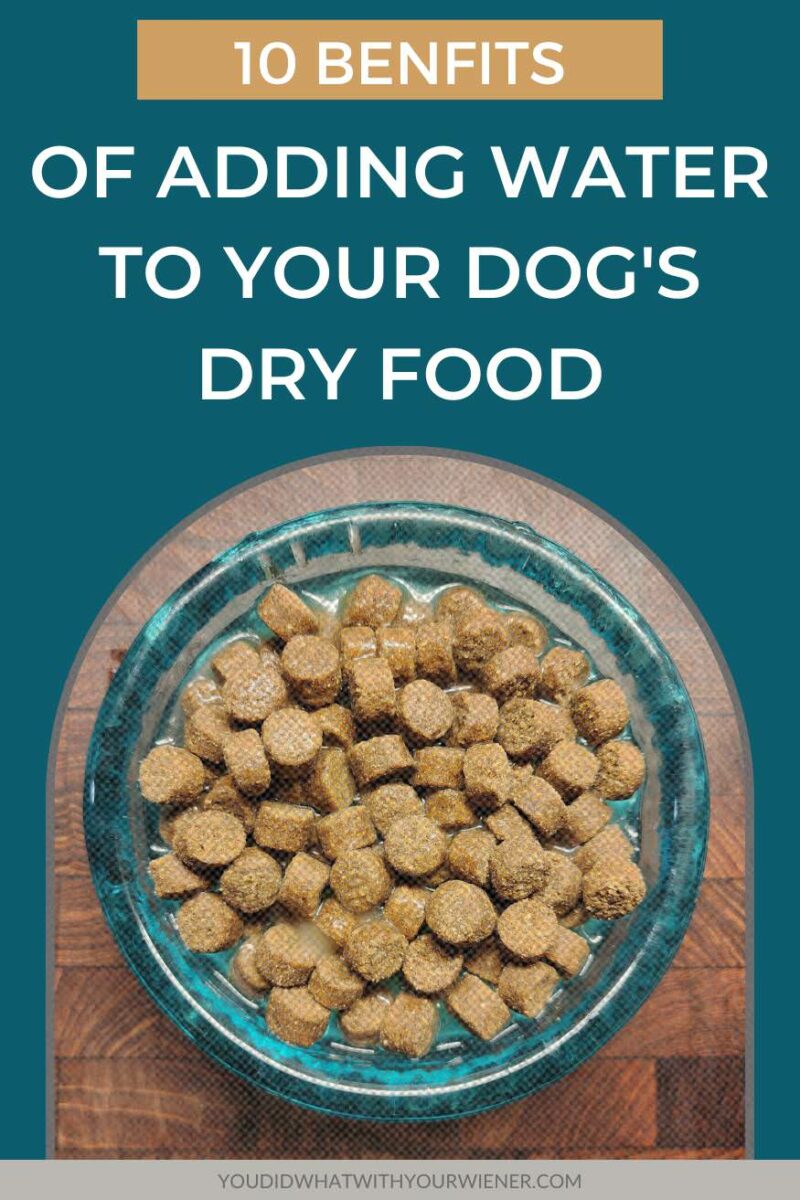10 Reasons to Add Water to Your Dog’s Dry Food
As a kid, I remember my Mom preparing our dog’s dry food, or kibble, for meals.
She added in a lot of things to make it more nutritious and tasty, including water.
This was before the internet so she must have learned it from a book, magazine, or it was passed along from knowledgeable dog owners.
A few years ago I thought I heard some “new information” about this practice that said that what she had been doing was wrong – that it’s a really bad idea to add water to dry kibble.

But I’ve done it myself over the years for various reasons and, logically, it didn’t make sense that it was harmful.
So I decided to do some research to get to the bottom of the issue – to confirm that either adding water to kibble was beneficial or proof that it was no longer a good practice.
Should You Add Water to Dry Dog Food?
I’m not sure where I got the impression that adding water to dry kibble was harmful because my research revealed more benefits than negatives.
The negatives are not insignificant, but they are more of a caution, or things to be aware of, than outright dangers.
Benefits of adding water to your dog’s kibble:
1) Increased hydration
Water is required for all cellular, organ, and tissue functions of the body.
In general, dogs should consume one ounce per pound of body weight every day to ensure that they are hydrated. (source)
If you dog doesn’t drink enough water, they could be come dehydrated. This, in turn, could lead to health issues.
Adding water to your dog’s food can help increase their overall fluid intake.
Remember that decreased thirst could be a sign of an underlying medical problem so if you dog’s drinking habits suddenly and significantly changed, talk to your veterinarian.
2) Slows down aggressive eaters
If your dog has a tendency to gulp, gobble, or eat their food very fast, gulpers, adding water to your dog’s dry food can cause them slow down.
If your dog eats their food too fast, it can cause bloat, choking, gagging, and vomiting.
I’ve found that the water method to slow eating is most effective when you add enough water that the kibble slightly floats (think bobbing for applies) and I don’t let it soak in.
3) Urinary tract health
A dog’s urinary system is what processes and removes waste from the body and this system depends on water to move waste through the system.
Adding extra water to your dog’s dry kibble can increase water intake.
4) More easily digested
Moistening dry dog food can help break down the food, making it easier for your dog to digest and absorb the nutrients.
5) Weight loss
If your dog needs to lose weight, you can replace part of their normal portion with a similar volume of calorie-free water.
Doing this will help your dog feel full and satisfied even though they are eating less kibble.
6) Entice picky eaters
While many dogs are food obsessed, some dogs are picky eaters.
Adding water to soften your dog’s kibble can make it more enticing because it smells and tastes better, leading to increased appetite and enjoyment of mealtime.
7) Easier to chew
If your dog has dental issues, missing teeth, or has difficulty chewing, moistening the food can make it easier for them to eat and digest.
8) Cost savings
All dog food has some moisture in it, even dry kibble (you can see this in nutritional analysis breakdown on the back of the package).
But, obviously, dry dog food has less moisture than canned or raw food.
Canned and kibble are typically more expensive than kibble, which means part of what you are paying for is water.
9) Consistency preference
Some dogs may prefer a softer, moister texture in their food, and adding water to dog kibble will help achieve this.
10) Bloat prevention
A dog fed a moist diet – raw, canned, or moistened dry food – is much less likely to develop bloat, also known as gastric dilatation and volvulus, which is a potentially life-threatening condition in dogs.
Reasons why you might not want to add water to your dog’s dry food:
There are some drawbacks to adding extra water to your dog’s food.
These include:
1) No teeth cleaning action
I’m mentioning this one because it’s a common claim that hard, dry kibble will help your dog’s teeth stay clean due to the chewing action.
However, this has not been my experience.
First, a dog must actually chew their food for this to be effective, and many just swallow it.
Second, my dogs have eaten different diets over the years and I saw no difference in the cleanliness of their teeth no matter which type – raw, canned, or dry kibble – they were eating.
But it is possible that chewing hard kibble can help keep some dog’s teeth clean so sofening with water would negate that benefit.
Personally, I don’t rely on my dog’s diet to help maintain dental health. Instead , I use this at-home teeth cleaning technique (it’s not brushing).
2) Increased meal prep time
You’ll see below that you should add the water at meal time and then wait 1-5 minutes for the dry food to soften, thus adding significant time to meal prep.
If you’re in a hurry, or like to keep the process and quick and easy as possible, then soaking your dog’s dry kibble in water may not be for you.
3) Unappetizing texture
While some dogs prefer to eat soft, moist food, some do not.
Adding water to your dog’s kibble may make the texture unappetizing and less enjoyable.
4) Wasted food
Moistening your dog’s dry dog food can reduce the shelf life.
Since you should place any uneaten soft kibble in the refrigerator, there is potential for it to dry out and no longer taste good to your dog.
Also, any moistened kibble should be thrown out after 24 hours if not eaten to reduce the risks of spoilage.
This means that you may end of throwing out some of the dog food that you purchase.
5) Water intoxication
Believe it or not, it is possible to over-hydrate your dog. It’s called water intoxication, or hyponatremia in medical terms.
If you add too much water to your dog’s food, it’s possible to overhydrate them, which can be harmful to your dog’s health.
When a relatively large amount of water is consumed in a short period of time, the balance of electrolytes in the dog’s body is disrupted, which can cause a disturbance in brain function.
Symptoms of water intoxication include staggering, loss of coordination, lethargy, nausea, vomiting, dilated pupils, light gum color, and excessive salivation.
While water intoxication is relatively rare, and dogs that swim, drink excessive water after exercise, or “catch” pressurized water from the hose are at the highest risk, it is possible it could happen from putting way too much water in your dog’s food.
Make Your Own Determination
It’s important to make your own determination when deciding to add water to your dog’s dry food or not.
Consider the pros and cons above and decide if you think it may help your own dog.
Then give it a try and see if it works for you and your dog likes it.
If you have concerns or notice any negative changes in your dog’s health after adding water to their food, it’s best to stop and consult with your veterinarian.
If you do decide to put water in your dog’s food at mealtime, follow the directions below.
How to Add Water to Your Dog’s Food
Adding water to your dog’s dry food seems pretty straightforward but there are some nuances to enduring it’s effective and safe.
To add water to dry dog food, follow these steps:
- Measure out the correct portion of dry food based on your dog’s size, age, and activity level.
- Place the dry food in a bowl.
- Pour 1 Tbsp. to 1/4 c lukewarm water (not hot or boiling, water over the food to prevent any risk of them burning their mouth), deepening on the amount of food and the size of your dog, over the kibble.
- Gently mix it with a spoon to help moisten all of the pieces.
- Let the food soak for 1-5 minutes until it reaches the desired consistency (typically, partially softened but not mush).
- Stir the food again to evenly distribute the water and softened kibble pieces.
- Serve the moistened food to your dog immediately.
Put any moistened food your dog didn’t eat in the refrigerator to offer at the next meal.
If your dog doesn’t eat it after 24 hours, throw it out to reduce the risk of it spoiling or becoming contaminated with bacteria.
Alternatives to Water
Adding water to your dog’s kibble is the simplest way to gain the benefits of moistened kibble.
But it’s not the only way.
There are other liquids that you can use that will nutritionally enhance your dog’s meal.
Bone Broth
There are many benefits of bone broth for your dog, including promoting a healthy gut, supporting the immune system, and tempting picky dogs.
Bone broth is also a natural source of glucosamine to help support healthy joints and cartilage.
You can buy pre-made bone broth at most pet stores or use this easy bone broth recipe to make your own.
Goat’s milk
While your dog should not drink cow’s milk, goat’s milk raw goat’s milk contains far less lactose than cow’s milk and is generally safe.
Goat’s milk is a source of probiotics, which are good for digestive health, and can help generally support dog’s with health issues.
Dog hydration/electrolytes drink
If your dog is dehydrated, vomiting, or has diarrhea, they may need electrolytes in addition to extra water.
Electrolytes help to maintain normal fluid balance in the blood and tissues.
You can add electrolytes to your dog’s meal by using something like Nulo Hydrate or Vet Classics Pet-A-Lyte (affiliate links) in place of plain water.
Final Thoughts
There are many benefits to adding water to your dog’s dry food like helping to prevent dehydration, increased digestibility, making it easier to chew, and helping with weight loss.
You can also swap out all or part of the plain water with other liquids, like goat’s milk, bone broth, or oral electrolyte solutions, for additional benefits.
If you have concerns or notice any negative changes in your dog’s health after adding water to their food, it’s best to stop and consult with your veterinarian.


About the Author
Hi, I’m Jessica. I’ve been studying the Dachshund breed since 2007, owned 3 of my own, and shared in the lives of thousands of others through their owner’s stories. When I’m not sharing what I know on this blog, you can find me hiking, camping, and traveling with my adventurous wiener dogs.
